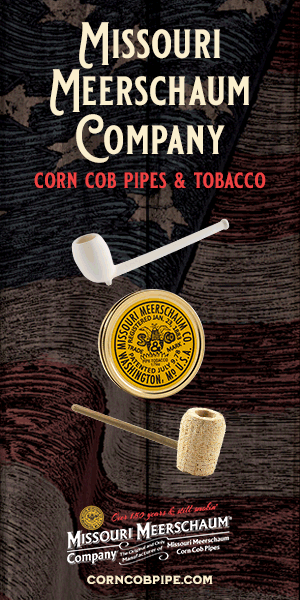That's a touchy question, pitchfork. I made a vow to myself to never disparage or criticize another pipemaker's work unsolicited openly on social media so I have to tread lightly. Besides, who am I to be the judge. Every pipemaker started out making "turd pipes" and almost all of them (myself included) put some on the market early on mostly out of ignorance of what a quality pipe should be. A poorly made pipe is one that lacks a certain level of quality in all of the categories you mention. There is less room for variation in terms of how a pipe should be properly engineered to maximize performance. Here's are some things I would identify as qualities of a well made pipe.
Engineering:
-airway diameter between 9/64" and 5/32" or metric equivalents
-airway diameter in the bowl equals the airway diameter tapered in the stem
-V-slot at least 3/4" deep in the stem that widens at least to the width of the airway (9/64" or 5/32") to eliminate restrictions in the airway
-slot height of 3/64" to 1/16"
-stem airway that is smooth and preferably polished
-airway in the bowl terminates in the center of the bottom of the mortise or is ramped to properly meet at the center of the mortise in bent pipes when the design doesn't allow drilling to terminate in the bottom center
-countersunk airway at the end of the tenon
-approximately 1mm gap between the end of the tenon and the bottom of the mortise
-airway in the bowl line up with the airway in the stem/tenon without lips, burs, steps, etc that could cause turbulence
-airway that terminates bottom center of the tobacco chamber
-bowl walls at least 1/4" thick in all areas
-tobacco chamber diameter between 11/16" and 1 1/8"
Fit and Finish/Comfort:
-bit thickness between 0.17" to 0.14" behind the button
-slot edges rounded and smooth
-button height and depth not too small or big (I don't know an acceptable range here but know the range I like mine)
-no sharp points on the button but still crisp in appearance
-stem and shank face polished and finished
-No scratch/tool marks on a smooth finish and stem
-slightly rounded and polished outer edge of tenon (prevents wearing the walls of the mortise over time resulting in a loose fitting stem)
-no sharp edges around the outer edge of the tobacco chamber at the rim
-stem thickness typically between approximately 3/4" and 1" (give or take)
-finish even without blotchiness and polished smooth with no overbuffed areas
-No known natural flaws that go deep enough to violate the 1/4" wall thickness rule and definitely no flaws that go all the way from the outside of the bowl to the inside of the chamber
-no flaws in the tobacco chamber more than sand specks
-tobacco chambers sanded smooth
-stain doesn't bleed on hands when held and smoked
-airway in the briar isn't burnt while drilling
-airway is deburred where it enters the tobacco chamber
-mortise is chamfered slightly at the shank end
Aesthetics:
This one is tougher to nail down because beauty is in the eye of the beholder but there are certain things that definitely help so I'll list a few that are often discussed on the pipemaker's forum.
-stem angle follows the visual line of the shank
-stem length proportionate to the overall design of the pipe (this one is complex and the general rules one can follow would take too much time to describe)
-bend in the stem compliments the lines/curves of the pipe visually. Typically slightly underbent is better than overbent.
-symmetrical designs are actually symmetrical from left to right and often front to back as pertains to the bowl
-shape compliments the grain and lines up optimally with the shape
-certain size and number of surface flaws result in a rusticated or sandblasted pipe rather than left smooth and/or filled
-bowl size is proportionate to the shank and stem size
-even finish whether smooth, rusticated, or sandblasted
-transition between shank and bowl is cut properly (common mistakes are making the transition too sharp or not removing enough material)
-adornments are well proportioned (ie. shank rings aren't too thick or significantly bigger in diameter compared to the shank, shank rings that are too thick, etc.)
I'm sure I've missed a lot here but it's a pretty good place to start. Also, slight variations from some of these points may not result in a bad pipe in and of themselves but can pose other problems. For example, some like an 11/64" airway for a more open draw but the draw back is that tobacco can get in the airway a bit easier.
Engineering:
-airway diameter between 9/64" and 5/32" or metric equivalents
-airway diameter in the bowl equals the airway diameter tapered in the stem
-V-slot at least 3/4" deep in the stem that widens at least to the width of the airway (9/64" or 5/32") to eliminate restrictions in the airway
-slot height of 3/64" to 1/16"
-stem airway that is smooth and preferably polished
-airway in the bowl terminates in the center of the bottom of the mortise or is ramped to properly meet at the center of the mortise in bent pipes when the design doesn't allow drilling to terminate in the bottom center
-countersunk airway at the end of the tenon
-approximately 1mm gap between the end of the tenon and the bottom of the mortise
-airway in the bowl line up with the airway in the stem/tenon without lips, burs, steps, etc that could cause turbulence
-airway that terminates bottom center of the tobacco chamber
-bowl walls at least 1/4" thick in all areas
-tobacco chamber diameter between 11/16" and 1 1/8"
Fit and Finish/Comfort:
-bit thickness between 0.17" to 0.14" behind the button
-slot edges rounded and smooth
-button height and depth not too small or big (I don't know an acceptable range here but know the range I like mine)
-no sharp points on the button but still crisp in appearance
-stem and shank face polished and finished
-No scratch/tool marks on a smooth finish and stem
-slightly rounded and polished outer edge of tenon (prevents wearing the walls of the mortise over time resulting in a loose fitting stem)
-no sharp edges around the outer edge of the tobacco chamber at the rim
-stem thickness typically between approximately 3/4" and 1" (give or take)
-finish even without blotchiness and polished smooth with no overbuffed areas
-No known natural flaws that go deep enough to violate the 1/4" wall thickness rule and definitely no flaws that go all the way from the outside of the bowl to the inside of the chamber
-no flaws in the tobacco chamber more than sand specks
-tobacco chambers sanded smooth
-stain doesn't bleed on hands when held and smoked
-airway in the briar isn't burnt while drilling
-airway is deburred where it enters the tobacco chamber
-mortise is chamfered slightly at the shank end
Aesthetics:
This one is tougher to nail down because beauty is in the eye of the beholder but there are certain things that definitely help so I'll list a few that are often discussed on the pipemaker's forum.
-stem angle follows the visual line of the shank
-stem length proportionate to the overall design of the pipe (this one is complex and the general rules one can follow would take too much time to describe)
-bend in the stem compliments the lines/curves of the pipe visually. Typically slightly underbent is better than overbent.
-symmetrical designs are actually symmetrical from left to right and often front to back as pertains to the bowl
-shape compliments the grain and lines up optimally with the shape
-certain size and number of surface flaws result in a rusticated or sandblasted pipe rather than left smooth and/or filled
-bowl size is proportionate to the shank and stem size
-even finish whether smooth, rusticated, or sandblasted
-transition between shank and bowl is cut properly (common mistakes are making the transition too sharp or not removing enough material)
-adornments are well proportioned (ie. shank rings aren't too thick or significantly bigger in diameter compared to the shank, shank rings that are too thick, etc.)
I'm sure I've missed a lot here but it's a pretty good place to start. Also, slight variations from some of these points may not result in a bad pipe in and of themselves but can pose other problems. For example, some like an 11/64" airway for a more open draw but the draw back is that tobacco can get in the airway a bit easier.








 :
: